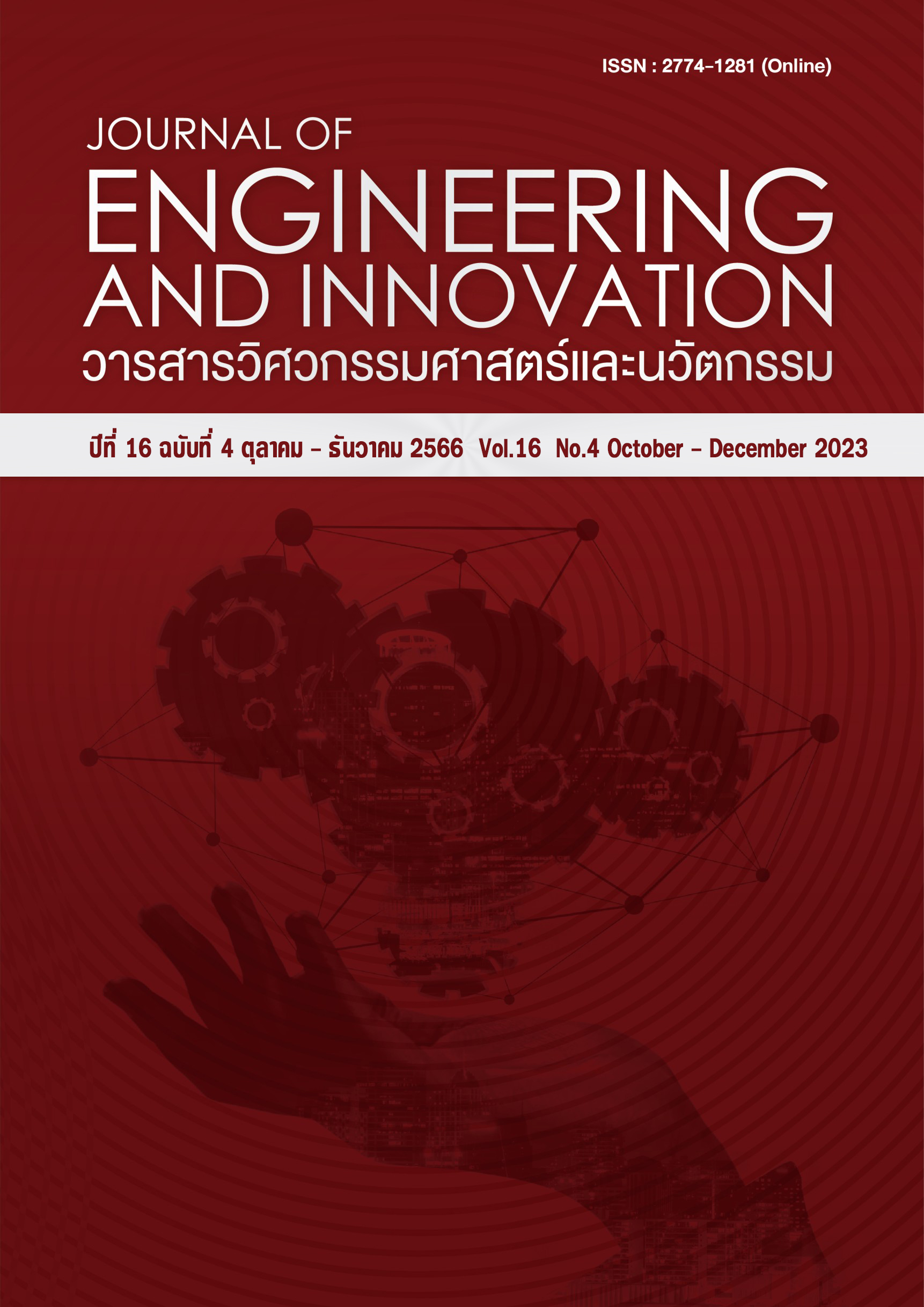Porous concrete block improvement with reinforced material ไทย
Main Article Content
Abstract
This research focused on the compressive strength, flexural strength, and water permeability of porous concrete. Round aluminum wire in two diameters of 2 mm and 4 mm, was combined with cement to coarse aggregate in a ratio of 1:25, limestone in which retained on sieve No. 4, and superplasticizer. The sample of porous concrete blocks sizing 52×20×7.5 (length × width x depth/ height) cm was used in this whole experiment. The addition of 2 mm and 4 mm aluminum wires in two forms of wire reinforcement in porous concrete was studied. According to the results, sizing of aluminum wire revealed an impact on the increase in flexural strength of porous concrete than compressive strength. The sizing of an aluminum wire affected to the obtained flexural strength than reinforcing form. The water permeability of porous concrete (k) was 1.99 cm/s at the age of 28 days. The water permeability of porous concrete was not significantly affected by the curing time.
Article Details
References
ปริญญา จินดาประเสริฐ, ยุวดี แซ่ตั้ง. เทคโนโลยีคอนกรีตพรุน.ราชบัณฑิตยสถาน. 2557; 39(2): 61.
กมล ตรีผอง, รณกร เทพวงษ์. การศึกษาการซึมผ่านน้ำในคอนกรีตพรุนโดยใช้มวลรวมหยาบรีไซเคิล. การประชุมวิชาการวิศวกรรมโยธาแห่งชาติ ครั้งที่ 25. 2563.วันที่ 15-17กรกฎาคม. จ.ชลบุรี. 2563; MAT 13-20.
Bhutta MAR, Tsuruta K, Mirza J. Evaluation of high-performance porous concrete properties. Construction and Building Materials. 2012; 31: 67-73.
ปรเมธี เดชปะตังเวสา, โกมิลย์ ชัยรัตนงานเดช, พงศกร พวงชมภู. การวิเคราะห์สาเหตุการวิบัติเชิงลาด และแนวทางการปรับปรุงแก้ไข: กรณีศึกษา ทางหลวงหมายเลข 1194 ตอน แม่สะเรียง – แม่สามแลบ ที่ กม. 21+150. KKU Research Journal (Graduate Studies). October-December. 2019; 19(4): 127-138.
Horpibulsuk S. Foundation Engineering. Institute of Engineering, Suranaree University of Technology. 2012.
American Concrete Institute. ACI 522R-10: Report on Pervious Concrete. ACI Manual of Concrete Practice. Detroit, USA. 2010.
Zaetang Y, Wongsa A, Sata V, Chindaprasirt P. Use of lightweight aggregates in pervious concrete. Construction and Building Materials. 2013; 48: 585-591.
ประชุม คำพุฒ. คอนกรีตพรุนโดยวิธีผสมผงอะลูมิเนียม.วารสารวิศวกรรมศาสตร์ ราชมงคลธัญบุรี. 2545; 1(2): 46-51.
ยุทธนา บุญสินชัย, ศุภกิจ นนทนานันท์, อภินิติ โชติสังกาศ. กำลังรับแรงดัดและพฤติรรมการวิบัติของคอนกรีตพรุนโดยการประยุกต์ใช้วัสดุใยสังเคราะห์เสริมแรง. การประชุมทางวิชาการของมหาวิทยาลัยเกษตร์ศาสตร์ ครั้งที่ 51. 2556; 102-109.
วันชัย สะตะ, ปริญญา จินดาประเสริฐ. คอนกรีตพรุน : คอนกรีตที่เป็นมิตรกับสิ่งแวดล้อม. วารสารคอนกรีต สมาคมคอนกรีตแห่งประเทศไทย. ธันวาคม. 2560; 29(4): 11-28.
ยุวดี หิรัญ, ธวัชชัย ตันชัยสวัสดิ์, พลยุกต์ มูลรังษี, วิชัย บำรุงนาม, อัญชลี เพียสุระ. บล็อกปูถนนคอนกรีตพรุน. การประชุมวิชาการคอนกรีตประจำปี ครั้งที่ 4. 2551.
ถนัดกิจ ชารีรัตน์, ปริญญา จินดาประเสริฐ, Hatanaka S. คอนกรีตพรุน: คอนกรีตที่เป็นมิตรกับสิ่งแวดล้อม. การประชุมวิชาการวิศวกรรมโยธาแห่งชาติ ครั้งที่ 13, จอมเทียน ปาล์ม บีช พัทยา ชลบุรี. 2551.
ASTM C39-10. Standard Test Method for Compressive Strength of Cylindrical Concrete Specimens, American Society for Testing and Materials. West Conshohocken: ASTM International; 2015.
ASTM C78 / C78M-15. Standard Test Method for Flexural Strength of Concrete (Using Simple Beam with Third-Point Loading). West Conshohocken: ASTM International; 2015.
ASTM C1701/C1701M-17a. Standard Test Method for Infiltration Rate of In Place Pervious Concrete. West Conshohocken: ASTM International; 2017.
Chandrappa A K, Biligiri K P. Pervious concrete as a sustainable pavement material Research findings and prospects: A state of the art review. Construction and Building Materials. 2016; 111: 262-274.
Yu F, Daquan S, Jue W, Minjun H. Influence of aggregate size on compressive strength of pervious concrete. Construction and Building Materials. 2019; 209: 463-475.
Meininger R C. No-fines pervious concrete for paving. Concrete International. 1988; 10: 20-27.
ธนภร ทวีวุฒิ, นท แสงเทียน, วิวัฒน์ พัวทัศนานนท์ และ สถาพร โภคา. ผลของความหนาแน่นและอัตราส่วนที่มีต่อปริมาณช่องว่างอากาศในคอนกรีตมวลเบาแบบเซลลูล่าที่ใส่สารลดน้ำปริมาณมาก. วารสารวิชาการ วิศวกรรมศาสตร์ ม.อบ., 2561; 11(2): 1-12.
Prahara E, Meilani M. Compressive strength and water absorption of pervious concrete that using the fragments of ceramics and roof tiles. The European Physical Journal Conferences. 2014; 68: 6p.

